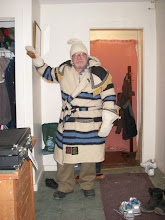…when human beings write, we give ourselves the chance to put thinking on the page, to hold our thinking in our hands, to put our thinking in a pocket and take it out another day. When we write, we can think about our thinking…and we can think with others about our thinking.
~Lucy Calkins
Or, as E. M Forster put it more succinctly, "How do I know what I think until I see what I say? "
Writing for me has been for many years has been entirely a way a way of dispensing information, not as a creative outlet. My thinking and my creativity are more manual, sculpting, sewing, cooking and building, making things with my hands. My thinking is therefor shown in the things I make and what I do, rather than I what I have written. Metacognition is not something I have traditionally engaged in. However, since I started thinking about teaching as a career and working with students learning about how to decipher words on a page, both in reading and in writing, I have come to realize that to teach, I have to be able to express in words concepts that cannot rely solely on imagery and that must be able to be saved in some form that can be examined at another time and perhaps with others.
Artists, both professional and life-style, have told me that the object is a sufficient repository of the thinking process, and that the intelligent viewer will appreciate and discern the artist's thought as he examines the object. This is, of course, the sort of malarkey you hear at gallery parties. While it is possible to discover meaning in a piece of art, the interpretation is often very personal and may entirely miss the artist's point, while still having total interpretive validity for the observer. “Words,” one might say,” can obfuscate or be open to misinterpretation as an ambiguous piece of art.” Yet it is true that, verbal as human beings tend to be, the best way to pass an idea from person to person is to explain it in words, and the best way to make it possible for more than one person to examine, think about and discuss the words or even to have them available to oneself at a later time is to write those words down. And once the words are on paper, it is possible to manipulate and refine them, to take whole chunks out and rethink and rewrite, to amend and append, to twist and mold the thought until it feels right or is wrong in just the right way. The act of writing then becomes a work of hand and mind together, art and science as one, a way of creating and thinking with blocks of words the way a child might build with blocks of wood, except that with the simple blocks of words, cathedrals greater than St. Peter's and edifices that could contain the world can be built.
As Henry David Thoreau once said, “If you have built castles in the air, your work need not be lost; that is where they should be. Now put foundations under them.“
On the other hand, teaching this stuff to first graders seems overwhelming. First graders are still at the level of thinking magically. For them, the bounds of reality are far more tenuous than they are for me. Their thinking is belief, and is often so far beyond what an adult can believe. In some ways, teaching them the tools to express their thoughts brings them out of the magical universe and into a world in which thoughts can be reined in and put down in a readable format that other can understand. I feel very frustrated at the pedantic assignments that my kids were given during their early years of writing. While it is true that kids need to learn about what constitutes a proper sentence and how to write a friendly letter, I feel that forcing their thought processes into acceptable form is a mistake early in the writing process. Children should be encouraged to write about whatever they want, no matter how bizarre or incorrect, to get them to a point where writing becomes a natural way for them to express their thinking, as natural as speech. Once they have gained this point, they can start to learn how to use writing to HELP them think. Unless they are accustomed to writing as a natural way to express themselves, they will not be comfortable using it as a handy tool for thinking and communication. I can remember my daughter filling page after page in her notebook long before she could read or write, each row of scribbles carefully in the lines, She would then “read” her work to us. We encouraged her scribbling with much attention and praise. We did not try and teach her to use letters and to write words at first. She was a bit slower to come to reading and writing words than other kids in her early school years, but she has been a prolific reader and writer ever since she got the connection between her earlier scribbling and word-crafting. I believe that encouraging her to become comfortable with the process of pencil manipulation without insisting on having it “make sense” to an adult habituated her to the use of writing as a tool for communication.
For a great page filled with quotes about writing, some serious, some very tongue-in-cheek, visit This site.

No comments:
Post a Comment